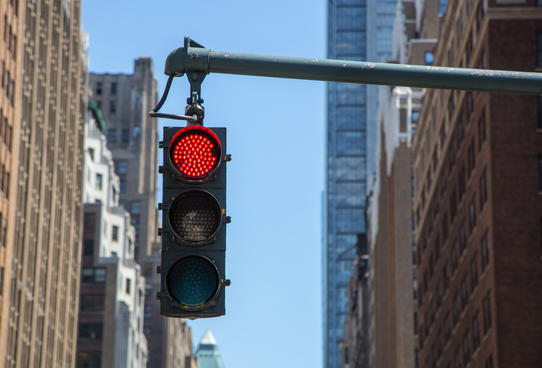We’ve all been there before — staring down that red light while becoming more impatient by the second and dreaming about breaking the rules of the road in order to get around it. Thankfully, and finally, Audi has decided to do something about these hold-ups by introducing a new feature that will let drivers know exactly when the traffic light they’re waiting at will change.

Image source: iStock.
Called a “traffic light information system,” the technology is set to be available on select 2017 models of Audi’s Q7, A4, and A4 allroad. This is a huge deal for the impatient driver and an even huger deal for the automotive industry. With the world’s only example of vehicle-to-infrastructure communication, the German automobile manufacturer is opening the road to a new era of cars as data-driven mobility devices.
Here’s the rundown on how this technology works: you’ll pull up to a red light and will immediately see a countdown in the car’s instrument cluster or heads-up display, which will show you how much longer you’ll be there until the light turns green. If the car is moving, the countdown will start if the upcoming light will be red by the time you reach the intersection. Because the traffic light system lets the car talk to the road, as your vehicle nears a traffic light, it will receive real-time data about the signals at that specific location.

Image source: Audi.
Besides curbing your impatience, what other perks does a feature such as this serve? According to Audi’s general manager of connectivity, Pom Malhotra, “a better-informed driver is a less stressed driver.” So basically, if you know you have 20 seconds before you get the green, for example, you can grind your teeth and grip your wheel, or you can take some time to speak with a passenger, or give your eyes and hands a quick break from their driving positions.
The infrastructure component of traffic light information is by far the most complex part and will roll out gradually in selected cities and metropolitan areas in the United States. Currently Audi won't identify where, but Malhotra projected that five to seven urban areas will be online by the end of this year, with more coming in 2017. According to Malhotra, Audi tested the service on 100 cars for over a year, and has been working with agencies that manage the 300,000 or so traffic lights in the United States and data provider Traffic Technology Solutions (TTS) or Portland, OR. TTS processes a constant stream of traffic signals in real time and sends them to Audi’s own servers, which are then sent to the cars.
Of course, the service will not be free. Additionally, the drivers of eligible models must purchase Audi’s Connect Prime infotainment package, which is $199 for six months or $750 for 30 months.
Source: PCWorld
Advertisement
Learn more about Electronic Products Magazine





